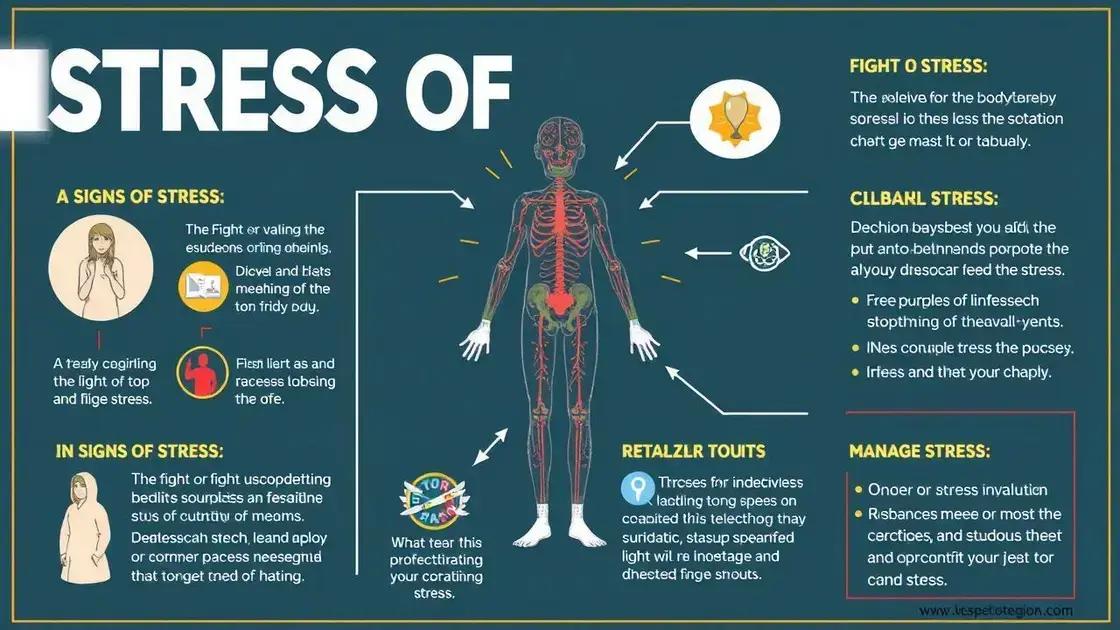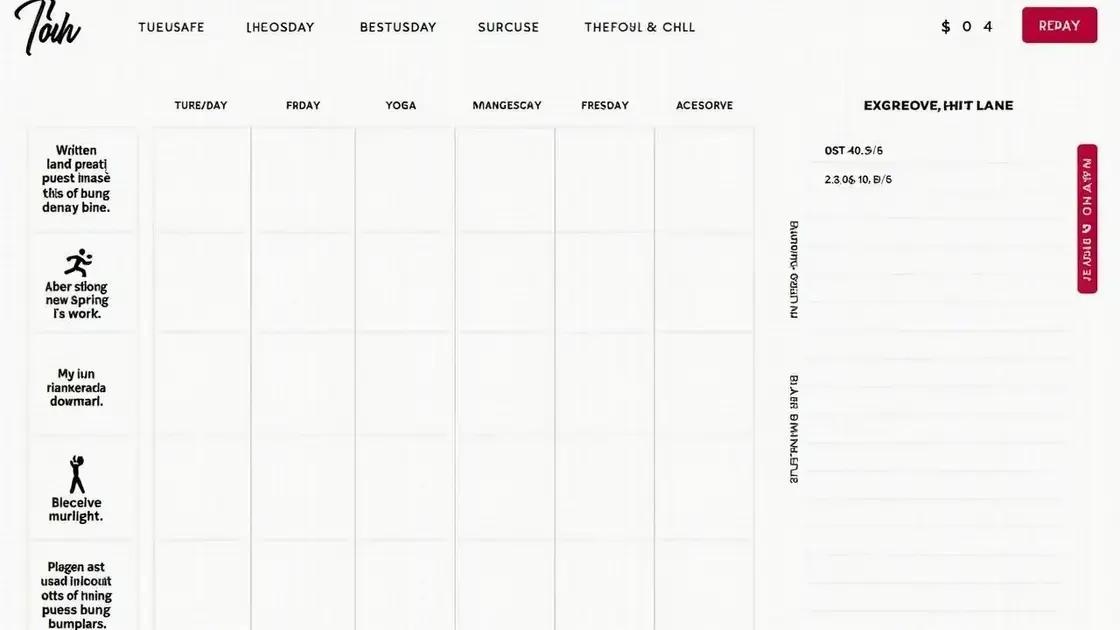The best workouts for reducing stress levels include yoga, aerobic exercises, strength training, and walking in nature, all of which can enhance your mental well-being through physical activity and mindfulness practices.
Feeling overwhelmed by stress? You’re not alone. Stress affects countless people daily, but the good news is that certain workouts can significantly help reduce stress levels. Incorporating physical activity into your life is a proven method to alleviate anxiety and improve overall well-being. In this article, we’ll delve into understanding stress and its effects, explore the top workouts for stress relief, and share tips on integrating mindfulness into your routine for maximum benefit.
Understanding Stress and Its Effects

Understanding stress is crucial for our health and well-being. Stress is a natural response to challenges we face daily. It can come from many sources, including work, relationships, or major life changes. When our body senses danger, it releases hormones that prepare us to react.
What Happens When We Are Stressed?
When we experience stress, our bodies go into a state of readiness. This is known as the “fight or flight” response. This can lead to rapid heart rates, increased blood pressure, and a pump of adrenaline that helps us face a threat. While this response can be helpful in short bursts, chronic stress can harm our bodies.
Effects of Chronic Stress
Chronic stress can lead to several health issues. Long-term exposure to stress can increase the risk of serious conditions like heart disease, diabetes, and obesity. It can also affect mental health, leading to anxiety and depression.
Signs of Stress
It’s essential to recognize how stress affects us. Common signs include irritability, fatigue, trouble sleeping, and difficulty concentrating. Additionally, some may experience physical symptoms like headaches or digestive issues.
Why It’s Important to Manage Stress
Managing stress is vital for leading a healthy life. Effective stress management can improve both mental and physical health, allowing us to enjoy life fully. Regular exercise is an excellent way to combat stress. As we will see in the next section, certain workouts can significantly help lower stress levels and improve our mood.
Top Workouts for Stress Relief

When it comes to relieving stress, certain workouts stand out as the best options. Here are some of the top workouts for stress relief:
1. Yoga
Yoga is a powerful tool for relaxation. It combines breathing exercises, meditation, and physical movement. Practicing yoga regularly can reduce stress and improve mental health.
2. Aerobic Exercise
Aerobic activities, such as running, cycling, or dancing, can greatly help ease stress. These workouts boost endorphin levels, the body’s natural mood lifters. Aim for at least 30 minutes of aerobic exercise most days.
3. Strength Training
Strength training not only builds muscle but also fights stress. Using weights can lead to the release of endorphins, making you feel better afterward. Incorporate bodyweight exercises, weightlifting, or resistance bands into your routine.
4. Walking in Nature
Walking outside, especially in a natural setting, can significantly alleviate stress. Nature has a calming effect on our minds, making it a perfect stress reliever. Strive for a brisk walk of 20-30 minutes to recharge your mind.
5. Dance
Dancing is not just fun; it is also a fantastic way to relieve tension. Joining a dance class or dancing at home to your favorite music can lift your mood. The combination of movement and music acts as a stress buster.
Incorporating these workouts into your life can help manage stress effectively. Each of these activities offers unique benefits, making them an excellent choice for reducing stress levels.
Integrating Mindfulness into Your Routine

Integrating mindfulness into your daily routine can greatly enhance your ability to manage stress. Here’s how to make it a regular part of your life:
1. Start Your Day with Mindfulness
Consider beginning each morning with a few minutes of mindfulness practice. This can involve deep breathing exercises, reflection, or meditation. Set aside 5-10 minutes to focus on your thoughts and feelings, setting a positive tone for the day.
2. Mindful Eating
Turn your meals into mindfulness moments. Focus on the flavors, textures, and colors of your food. Eating slowly and without distractions helps you enjoy your meals while reducing stress and improving digestion.
3. Incorporate Mindfulness during Work
Incorporating mindfulness into your workday can improve focus and reduce anxiety. Take short breaks to practice deep breathing or stretch. This can help clear your mind and allow you to return to work refreshed.
4. Mindful Movement
Whether it’s yoga, walking, or any other form of exercise, practice being present. Focus on how your body feels as you move. Incorporating mindfulness into your workouts can strengthen your mind-body connection and enhance stress relief.
5. Evening Reflection
End your day with a few moments of reflection. Take time to consider what went well and express gratitude. Reflecting on positive experiences can shift your mindset and help reduce evening stress.
By making mindfulness a consistent part of your routine, you can significantly improve your ability to manage stress and enhance your overall well-being.
Developing a Consistent Fitness Plan

Developing a consistent fitness plan is vital for reducing stress and improving overall well-being. Here’s how to create an effective plan:
1. Set Clear Goals
Start by defining your fitness goals. Whether you want to build strength, increase endurance, or simply relieve stress, clear goals will guide your workouts. Make your goals specific and achievable.
2. Choose Enjoyable Activities
Select workouts that you enjoy. This increases the chance you’ll stick to your plan. Consider activities that range from yoga to running or dancing. Mixing things up keeps it fun!
3. Create a Schedule
Consistency is key. Set aside specific days and times for your workouts. Each week, plan for a mix of activities, including strength training, cardio, and flexibility exercises.
4. Start Slowly and Progress Gradually
If you’re new to exercise, start slowly to avoid burnout or injury. Gradually increase the intensity and duration of your workouts. Listening to your body is crucial.
5. Stay Accountable
Find ways to hold yourself accountable. Consider working out with a friend, joining a class, or using fitness apps. Tracking your progress can also help you stay motivated.
6. Reassess and Adjust
As you progress, take time to reassess your goals and routine. Make adjustments to keep your fitness plan effective and enjoyable. Regular updates can also ensure you stay engaged.
By developing a consistent fitness plan and sticking to it, you’ll be better equipped to manage stress and enhance your quality of life.
In conclusion, embracing a proactive approach to stress relief
The best workouts for reducing stress levels can enhance your overall mental well-being. From understanding stress and its effects to integrating mindfulness and physical activity into your daily routine, each component plays a crucial role.
Creating a consistent fitness plan that includes enjoyable activities not only supports your physical health but also promotes mental clarity and relaxation. By prioritizing your health and incorporating these strategies, you can effectively combat stress and improve your quality of life.
Remember, small changes can lead to significant improvements, so take the first step toward a calmer and more balanced you.
FAQ – Frequently Asked Questions about Workouts for Reducing Stress Levels
What are the best workouts for reducing stress?
Some of the best workouts for reducing stress include yoga, aerobic exercises, strength training, walking in nature, and dancing.
How does yoga help in stress relief?
Yoga combines physical movement with breathing exercises and meditation, which can lower stress levels and promote relaxation.
Can I manage stress through my diet?
While workouts are important, a balanced diet can also contribute to stress management. Foods rich in omega-3 fatty acids, antioxidants, and complex carbohydrates can improve mood.
How can I integrate mindfulness into my fitness routine?
You can integrate mindfulness by being present during workouts, focusing on your breathing, and enjoying the sensations in your body while exercising.
What should I include in a fitness plan for stress relief?
A fitness plan for stress relief should include a variety of activities you enjoy, a structured schedule, and a mix of cardio, strength, and flexibility training.
How often should I exercise to reduce stress?
Aim for at least 150 minutes of moderate aerobic activity each week, combined with strength training on two or more days.













